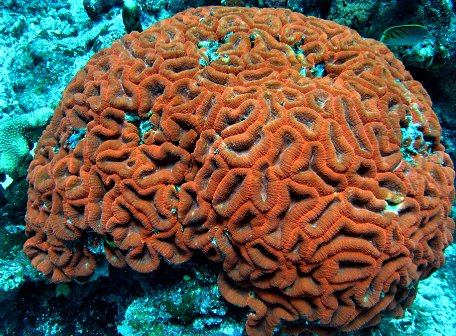
Brain microscopic anatomy in persons with autism shows an increase in the numbers of neuronal "dentritic spines" whuch conect neighboring cells in the brain. The dendritic spine density of the apical dendrites of pyramidal neurons are increased in several cortical layers (cortical layer 2 in frontal and parietal lobes and layers 2 and 5 in the temporal lobes). Spine density seems inversely correlated with cognitive function. Neurologists have hypothesized that the autism patient's brain is locally overconnected, so that the good connections are crowded out by poorly pruned, inefficient ones.
Something along those lines seems to fit the report below. Perhaps even in the first year of life, the brains of those who are to more obviously develop autism in the second year of life grow in a way that causes an unusual increase in cortical surface area. That means that their outer brain cortex is actually expanding faster than that of normal infants. Unfortunately, not all such brain size increases are desirable ones.
======================================================
ABSTRACT
Early brain development in infants at high risk for autism spectrum disorder
Heather Cody Hazlett, Hongbin Gu, Brent C. Munsell, Sun Hyung Kim, Martin Styner, Jason J. Wolff, Jed T. Elison, Meghan R. Swanson, Hongtu Zhu, Kelly N. Botteron, D. Louis Collins, John N. Constantino, Stephen R. Dager, Annette M. Estes, Alan C. Evans, Vladimir S. Fonov, Guido Gerig, Penelope Kostopoulos, Robert C. McKinstry, Juhi Pandey, Sarah Paterson, John R. Pruett, Robert T. Schultz, Dennis W. Shaw, Lonnie Zwaigenbaum, et al.
Nature 542, 348–351 (16 February 2017) doi:10.1038/nature21369
Received 15 April 2016 Accepted 06 January 2017 Published online 15 February 2017
Brain enlargement has been observed in children with autism spectrum disorder (ASD), but the timing of this phenomenon, and the relationship between ASD and the appearance of behavioural symptoms, are unknown. Retrospective head circumference and longitudinal brain volume studies of two-year olds followed up at four years of age have provided evidence that increased brain volume may emerge early in development. Studies of infants at high familial risk of autism can provide insight into the early development of autism and have shown that characteristic social deficits in ASD emerge during the latter part of the first and in the second year of life. These observations suggest that prospective brain-imaging studies of infants at high familial risk of ASD might identify early postnatal changes in brain volume that occur before an ASD diagnosis. In this prospective neuroimaging study of 106 infants at high familial risk of ASD and 42 low-risk infants, we show that hyperexpansion of the cortical surface area between 6 and 12 months of age precedes brain volume overgrowth observed between 12 and 24 months in 15 high-risk infants who were diagnosed with autism at 24 months. Brain volume overgrowth was linked to the emergence and severity of autistic social deficits. A deep-learning algorithm that primarily uses surface area information from magnetic resonance imaging of the brain of 6–12-month-old individuals predicted the diagnosis of autism in individual high-risk children at 24 months (with a positive predictive value of 81% and a sensitivity of 88%). These findings demonstrate that early brain changes occur during the period in which autistic behaviours are first emerging.





No comments:
Post a Comment